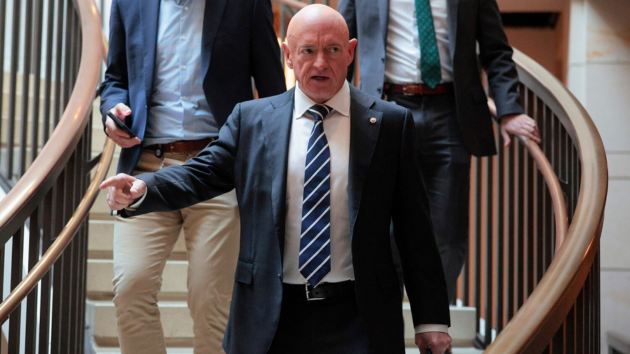This automaker has an answer to electric sports car
Written by ABC Audio All Rights Reserved on April 14, 2024

(NEW YORK) — Are we entering a “performance arms race” between internal combustion engine and electric sports cars?
Some engineers and top auto executives are beginning to question the superiority of electric sports cars, which have become a contentious topic among enthusiasts.
This week, Lawrence Stroll, executive chairman of Aston Martin, told reporters at the company’s U.K. headquarters that Aston is delaying its shift to electrics, focusing instead on plug-in hybrids.
“We are going to invest much more heavily in our PHEV program to be a bridge between full combustion and full electric,” Stroll said, according to Road & Track.
Stroll noted the “real lack of consumer demand” for electric sports cars. “We speak to our dealers, we speak to our customers — when you have a small network you can communicate easily. And everyone said we still want sound, we still want smell,” he said.
British marque McLaren, known for its seductive — and fear-inducing — supercars, recently launched its 750S coupe and spider, successors to its widely successful 720S. The brand has one hybrid on sale, the Artura, which launched in 2022. Customers, however, still demand the palpable acoustics of the raucous twin-turbo 4.0-liter V8 positioned behind the driver’s seat. The 750S may be the epitome of internal combustion engine (ICE) ingenuity.
Chief engineer Sandy Holford said his team truly raised the bar on the 750S, making it the lightest and most powerful series production McLaren to date. “It offers more thrills, more power and more torque, as well as improved ergonomics and engagement,” Holford said.
The car’s stats are also mind-bending, even without an electric motor: zero to 60 mph in 2.7 seconds; 740 horsepower; 590 lb-ft of torque.
ABC News spoke to Holford about the push for electric sports cars and their limitations. The conversation below has been edited.
Q: We’re seeing more electric supercars and hypercars. Will the popularity of the 750S be short-lived as more automakers build all-electric sports cars?
A: In the performance figures arms race, there’s going to come a point where physics gets in the way. And you can have all the power in the world but if you can’t make the rubber stick when you pull away, it’s not going to help you. It all depends on what the customers want. You can do naught to 60 mph in an insane time, but you can only do half a lap at pace because of the battery pack. There’s a balance to be had — for us that’s road use and track use for the 750S. This car is a different proposition to an EV car.
For people who are thinking about the 750S, get out and try it. We can write about it, we can talk about it, but the proof is in the pudding and getting behind the wheel. It’s about trying to be the ultimate engagement car for people.
Q: How long have you been working on the 750S?
A: The 750S development was around two years plus some small amount of refining time at the end, just really validating everything we tested through the development program and real-world customer situation driving.
Q: You benchmarked the 750S against its predecessor, the 720S. What was your objective with this car?
A: The 720S was revolutionary in its time — from an aerodynamic development point of view but also from a dynamic performance. The target for us was to understand where we can push this further but also to really make this car a driver-centric vehicle. How could we focus on engagement and a sense of connection to the car — from the way the car responds to you in terms of pedal mapping and gear shifts maps — to the audio and sound effect of the exhaust.
We moved everything around the cabin to be really focused on where the driver is sitting. Every switch that is commonly used has been moved closer to the steering wheel.
The challenge was to stretch the top end of performance for the 750S without losing any of the comfort and everyday usability. We moved switches and controls to a place that didn’t exist in the previous car. For example, putting a dedicated switch for the car’s nose lift is one of the pieces of feedback we had. The stalk was harder to find in the 720S. The nose lift is now twice as fast.
All of our cars are designed to be drivers’ cars; however, we continue to evaluate and improve based off customer feedback and our own benchmarking.
Q: Racing is at the heart of all McLaren cars. Is this the closest owners will get to driving an F1 car?
A: From a McLaren point of view – no. This is a road car that can be taken on the track. Our Ultimate Product Offering is usually closer to a racing vehicle – like a Senna GTR.
Q: Does the 750S mimic anything that professional drivers experience?
A: We take a lot of cues from our racing colleagues in terms of the way we develop: Our phrase is: “Fail fast, iterate and go again.”
The thing about the 750S is the breadth of capability it has. The car will look after you [on a track]. As you gain confidence in it, you can gradually turn things up, you can turn things off. You can get into variable drift control.
Q: Why was it important for drivers to feel engaged at speeds under 40 mph?
A: With the improvements in technology we have, some vehicles can feel really slow at high speeds. And it’s really easy to let your speed drift up in a high-performance car because it handles so well.
It was really important to me that customers could experience that real engagement and that sense of exhilaration under [lesser] speeds. You don’t want to have a car that only feels fast at 150 mph on a track.
Lots of our customers will use that car on a track but not all of our customers will. I still wanted customers to feel like they have an engaging supercar.
Copyright © 2024, ABC Audio. All rights reserved.

 KVSP
KVSP 





